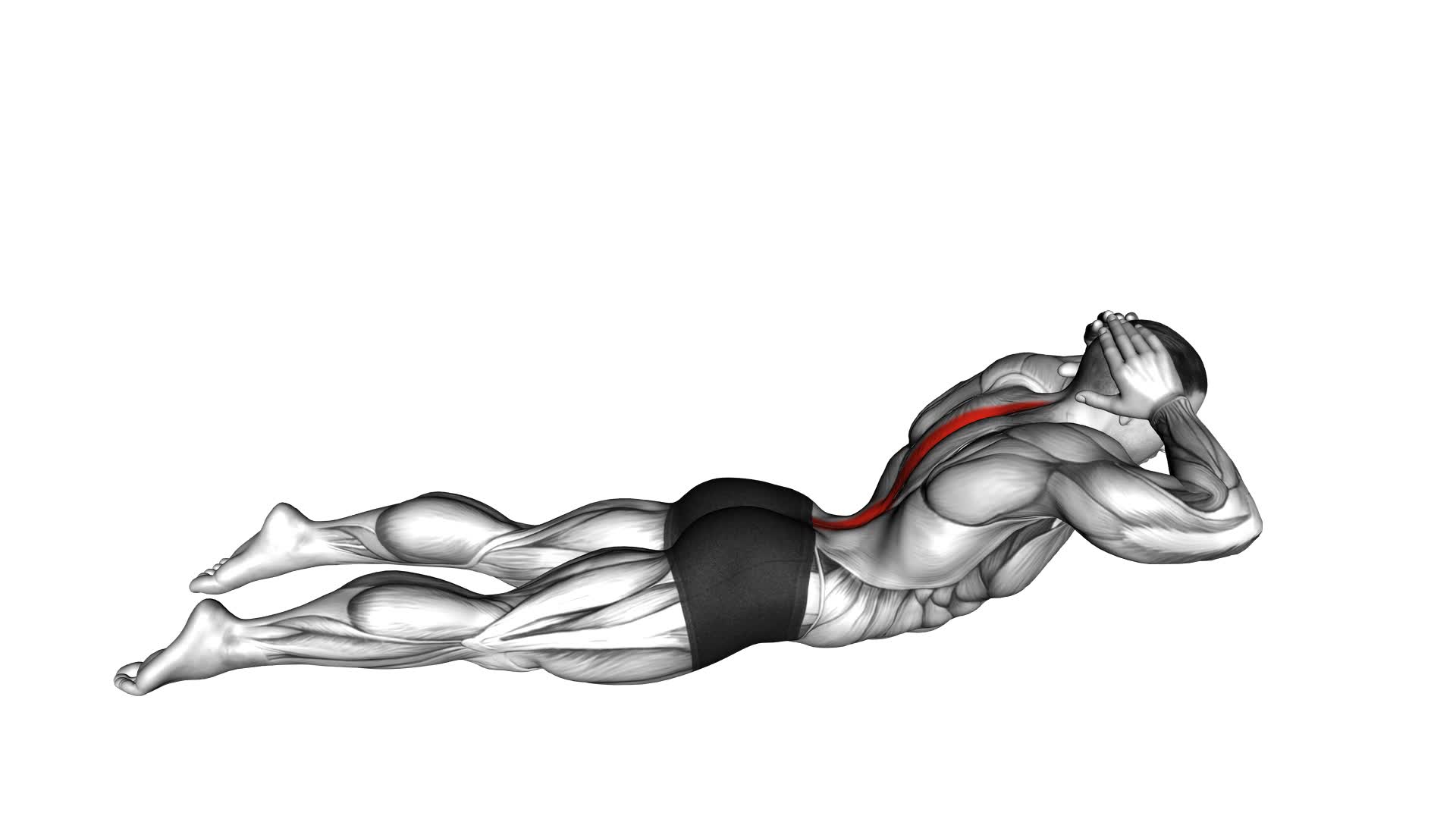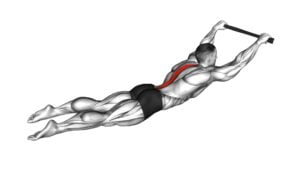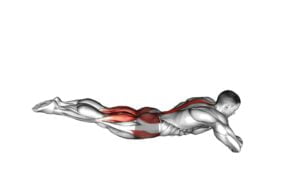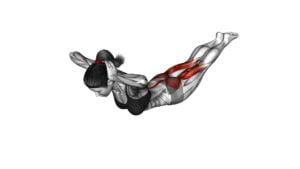Lying Floor Hyperextension – Video Exercise Guide & Tips

Looking to strengthen your back and core? Check out this video exercise guide on Lying Floor Hyperextension.
Watch This Exercise Video
In just a few minutes a day, you can reap the benefits of this effective exercise. Learn the proper form and technique, discover the equipment you'll need, and find modifications and progressions to challenge yourself.
Avoid common mistakes and get started with a sample workout. Get ready to feel stronger and more confident with Lying Floor Hyperextension.
Key Takeaways
- Lying floor hyperextension strengthens the lower back and glutes.
- It improves spinal health and alignment.
- Engaging core muscles during this exercise enhances stability.
- Maintaining proper body alignment and muscle activation cues is crucial for safety and effectiveness.
Benefits of Lying Floor Hyperextension
To maximize the effectiveness of your workout, incorporating the lying floor hyperextension can provide numerous benefits for strengthening your lower back and glutes. This exercise specifically targets the muscles in your lower back and glutes, helping to build strength and stability in these areas.
One of the key benefits of the lying floor hyperextension is its positive impact on spinal health. By engaging the muscles in your lower back, this exercise helps to improve the stability and alignment of your spine. This can be particularly beneficial for individuals who experience lower back pain or have a history of spinal issues.
Additionally, the lying floor hyperextension is an effective exercise for core strengthening. While primarily targeting the lower back and glutes, this exercise also engages the muscles in your core, including your abdominals and obliques. Strengthening these muscles can improve your overall core stability and support better posture.
Incorporating the lying floor hyperextension into your workout routine can help to strengthen your lower back and glutes, while also providing spinal health benefits and core strengthening effects. Remember to maintain proper form throughout the exercise and start with a weight that's appropriate for your fitness level.
Proper Form and Technique
To perform the lying floor hyperextension exercise with proper form and technique, there are a few key points to keep in mind.
First, focus on maintaining proper body alignment throughout the movement, ensuring that your spine stays neutral and your core remains engaged.
Additionally, use muscle activation cues to target the glutes and hamstrings, such as squeezing your glutes at the top of the movement.
Lastly, be aware of common form mistakes, such as lifting your upper body too high or using momentum to complete the exercise, and strive to avoid them for optimal results.
Body Alignment Tips
Maintain proper body alignment during the lying floor hyperextension exercise to maximize effectiveness and prevent injury.
To ensure proper body alignment, start by lying face down on the floor with your legs extended straight behind you. Place your hands beside your head or cross them over your chest.
Engage your core muscles by drawing your navel towards your spine. As you lift your upper body off the floor, focus on keeping your neck in a neutral position and avoiding any excessive arching in your lower back. Keep your shoulders relaxed and avoid shrugging them towards your ears.
Throughout the exercise, maintain a straight line from your head to your heels, keeping your body in a straight, plank-like position.
By maintaining proper body alignment, you'll target the muscles in your lower back and glutes effectively while reducing the risk of injury.
Remember to always prioritize safety and listen to your body's limitations.
Muscle Activation Cues
Activate your muscles by focusing on proper form and technique during the lying floor hyperextension exercise. To ensure effective muscle activation, use muscle activation cues to engage the targeted muscles.
Start by lying face down on the floor, with your legs straight and arms extended overhead. As you lift your upper body off the ground, engage your glutes and lower back muscles by squeezing them together. Remember to maintain a neutral spine and avoid overextending.
Additionally, pay attention to your breathing technique. Inhale as you lower your upper body towards the floor, and exhale as you lift it up. This controlled breathing pattern helps stabilize your core and maximize muscle activation.
Common Form Mistakes
Avoiding common form mistakes is essential for maintaining proper form and technique during the lying floor hyperextension exercise. To ensure you're using proper form, it's important to focus on body alignment. Keep your body in a straight line from your head to your toes throughout the movement. Avoid arching your back excessively or allowing your hips to sag.
Additionally, maintain a neutral spine position by keeping your head aligned with your spine. Engage your core muscles and squeeze your glutes to support your body during the exercise. By maintaining proper form and body alignment, you can maximize the effectiveness of the lying floor hyperextension exercise and minimize the risk of injury.
Now let's discuss the equipment needed for this exercise.
Equipment Needed for the Exercise
To perform the lying floor hyperextension exercise, you'll need a mat or a soft surface to lie on. This will provide cushioning and support for your body throughout the exercise.
In addition to a mat, here are four other pieces of equipment you may need to perform the lying floor hyperextension exercise effectively:
- Hyperextension Bench: This specialized equipment is designed to target the lower back muscles during hyperextension exercises. It provides stability and allows you to adjust the angle of the exercise to suit your fitness level.
- Ankle Weights: Adding ankle weights can increase the resistance and challenge your muscles further. Start with lighter weights and gradually increase as your strength improves.
- Resistance Band: Using a resistance band can add resistance and help you engage your glutes and hamstrings more effectively during the exercise. It can also provide assistance if you need help with the movement.
- Towel or Pillow: Placing a towel or pillow under your hips can provide extra support and comfort during the exercise. It helps to maintain proper alignment and reduce strain on your lower back.
Remember, safety should always be the top priority when performing the lying floor hyperextension exercise. Make sure to follow these safety precautions:
- Start with a light weight or no weight at all, especially if you're a beginner.
- Maintain proper form throughout the exercise, keeping your back straight and engaging your core muscles.
- Avoid jerking or using momentum to perform the movement.
- If you have any pre-existing back conditions or injuries, consult with a healthcare professional before attempting this exercise.
Modifications and Progressions
Now let's explore some modifications and progressions for the lying floor hyperextension exercise.
If you're a beginner, there are alternative variations you can try to make the exercise more manageable.
On the other hand, if you're looking to challenge yourself, there are ways to advance the difficulty of the exercise.
Alternative Variations for Beginners
Start with a beginner-friendly variation by using a stability ball for added support and stability. This modification option is great for those who are new to the lying floor hyperextension exercise or who need extra assistance in maintaining proper form.
Here are four alternative variations for beginners to try:
- Stability ball hyperextension: Place your hips on the stability ball and position your feet against a wall for stability. Perform the hyperextension by lifting your upper body while keeping your core engaged.
- Bench hyperextension: Lie face down on a bench with your hips at the edge and your feet anchored. Lift your upper body off the bench, engaging your glutes and lower back muscles.
- Prone hold: Start by lying face down on the floor with your arms extended overhead. Lift your chest off the ground, focusing on maintaining a neutral spine.
- Quadruped hyperextension: Begin on all fours, with your hands directly under your shoulders and your knees under your hips. Lift and extend one leg behind you while simultaneously lifting the opposite arm off the ground. Repeat on the other side.
These beginner-friendly variations will help you build strength and stability while gradually progressing to the full lying floor hyperextension exercise.
Advancing the Exercise Difficulty
To advance the difficulty of the lying floor hyperextension exercise, you can incorporate modifications and progressions that challenge your core and back muscles even further.
One advanced technique is to perform the exercise with added resistance, such as holding a weight plate against your chest or using resistance bands. This will increase the intensity and force your muscles to work harder.
Another modification is to elevate your legs by placing them on an exercise ball or bench, which will further engage your lower back and glutes.
Proper breathing techniques are also crucial in advancing the exercise difficulty. Remember to inhale deeply before starting the movement and exhale as you lift your upper body off the floor. This will help stabilize your core and enhance the effectiveness of the exercise.
Common Mistakes to Avoid
Avoiding these common mistakes will improve your technique during the lying floor hyperextension exercise. To ensure you get the most out of this exercise, here are four common mistakes to avoid:
- Improper breathing technique: Many people hold their breath or inhale and exhale at the wrong times during the lying floor hyperextension. Remember to inhale as you lower your body down and exhale as you lift it back up. Proper breathing helps stabilize your core and maintain control throughout the movement.
- Using momentum: Avoid using momentum to swing your body up during the exercise. This takes away from the targeted muscle engagement and reduces the effectiveness of the exercise. Instead, focus on using your glutes and lower back muscles to lift your body up in a controlled manner.
- Overarching your lower back: It's important to maintain a neutral spine position throughout the exercise. Avoid excessive arching of your lower back, as this can put strain on your spine and increase the risk of injury. Engage your core muscles to stabilize your spine and keep it in a neutral position.
- Performing too many sets and reps: While it's important to challenge yourself, it's equally important to listen to your body. Start with the recommended sets and reps for your fitness level and gradually increase them over time. Pushing yourself too hard too soon can lead to muscle fatigue and increased risk of injury.
Sample Lying Floor Hyperextension Workout
To maximize the benefits of the lying floor hyperextension exercise and further enhance your technique, incorporate the following sample workout into your routine.
There are several variations of the lying floor hyperextension that you can try to target different muscle groups and add variety to your workout.
One variation is the weighted lying floor hyperextension, where you hold a weight plate or dumbbell against your chest while performing the exercise. This adds resistance and increases the intensity of the exercise.
Another variation is the single-leg lying floor hyperextension, where you perform the exercise with one leg at a time. This helps to isolate and strengthen the glutes and hamstrings on each side individually.
To incorporate the lying floor hyperextension into a full body workout, you can pair it with exercises like squats, lunges, and deadlifts to target the lower body. For the upper body, you can pair it with exercises like push-ups, rows, and overhead presses.
This will help you create a well-rounded workout that targets multiple muscle groups and promotes overall strength and stability.
Remember to start with lighter weights and gradually increase the intensity as you become more comfortable and confident with the exercise.
Frequently Asked Questions
Can Lying Floor Hyperextensions Help Improve Posture?
Lying floor hyperextensions can indeed help improve your posture. By incorporating the lying floor hyperextension technique into your workout routine, you can strengthen your back muscles and increase spinal stability. This exercise targets the erector spinae, which are responsible for maintaining good posture.
The benefits of lying floor hyperextensions include improved alignment, reduced back pain, and enhanced overall posture. So, if you're looking to improve your posture, consider adding lying floor hyperextensions to your exercise regimen.
How Often Should I Do Lying Floor Hyperextensions to See Results?
To see results from lying floor hyperextensions, it's recommended that you perform them regularly. Incorporate variations of the exercise to target different muscle groups and prevent plateauing.
Make sure to maintain proper form throughout the movement to avoid injury and maximize effectiveness.
Consistency is key, so aim for at least 2-3 sessions per week.
Remember to listen to your body and gradually increase the intensity as you get stronger.
Can Lying Floor Hyperextensions Help With Lower Back Pain?
Lying floor hyperextensions can be beneficial for your lower back pain. This exercise focuses on strengthening your core, which can alleviate pressure on your spine and provide support for your lower back.
By regularly incorporating lying floor hyperextensions into your workout routine, you may experience improved spinal health and reduced discomfort in your lower back.
Remember to consult with a healthcare professional before starting any new exercise program, especially if you have existing back pain.
Is It Normal to Feel Soreness in the Glutes After Doing Lying Floor Hyperextensions?
Feeling soreness in your glutes after doing lying floor hyperextensions is completely normal. It indicates that you're effectively targeting and engaging your glute muscles during the exercise.
To improve technique and reduce soreness, make sure to maintain proper form throughout the movement and gradually increase the intensity over time.
If the soreness persists or becomes too uncomfortable, you can try alternative exercises such as glute bridges or hip thrusts to target your glutes.
Can Lying Floor Hyperextensions Be Done by People With a History of Back Injuries?
Lying floor hyperextensions for core strength can be a beneficial exercise.
If you have a history of back injuries, modifications may be necessary.
It's important to consult with a medical professional or a qualified trainer who can provide guidance tailored to your specific needs.
They can suggest alternative exercises or adjustments to ensure you can safely engage in this exercise without exacerbating your previous injuries.
Always prioritize your safety and listen to your body's limitations.
Conclusion
In conclusion, the lying floor hyperextension is a beneficial exercise that targets the lower back and glute muscles. By maintaining proper form and technique, using the necessary equipment, and avoiding common mistakes, you can effectively perform this exercise.
Modifications and progressions can also be made to challenge yourself further. Incorporate the lying floor hyperextension into your workout routine for improved strength and stability in your posterior chain.

Author
Years ago, the spark of my life’s passion ignited in my mind the moment I stepped into the local gym for the first time. The inaugural bead of perspiration, the initial endeavor, the very first surge of endorphins, and a sense of pride that washed over me post-workout marked the beginning of my deep-seated interest in strength sports, fitness, and sports nutrition. This very curiosity blossomed rapidly into a profound fascination, propelling me to earn a Master’s degree in Physical Education from the Academy of Physical Education in Krakow, followed by a Sports Manager diploma from the Jagiellonian University. My journey of growth led me to gain more specialized qualifications, such as being a certified personal trainer with a focus on sports dietetics, a lifeguard, and an instructor for wellness and corrective gymnastics. Theoretical knowledge paired seamlessly with practical experience, reinforcing my belief that the transformation of individuals under my guidance was also a reflection of my personal growth. This belief holds true even today. Each day, I strive to push the boundaries and explore new realms. These realms gently elevate me to greater heights. The unique combination of passion for my field and the continuous quest for growth fuels my drive to break new ground.







